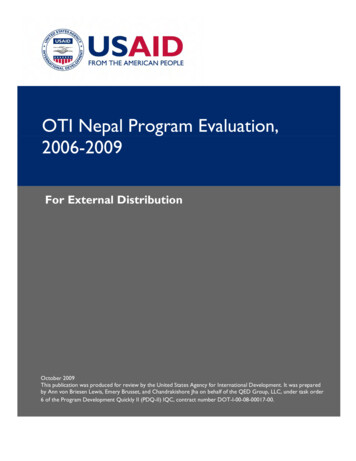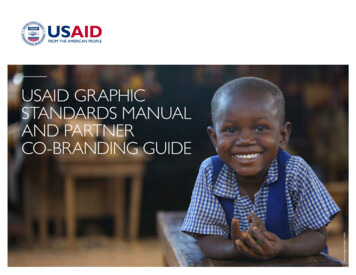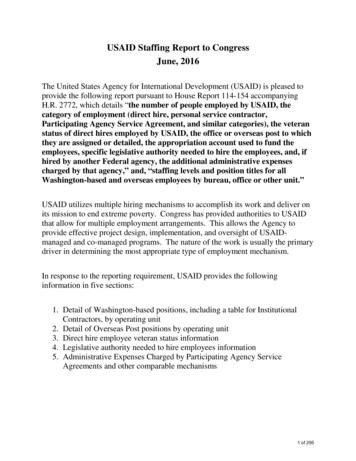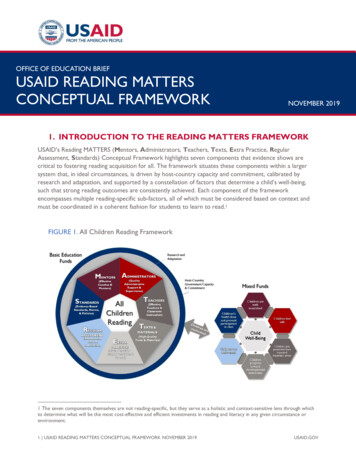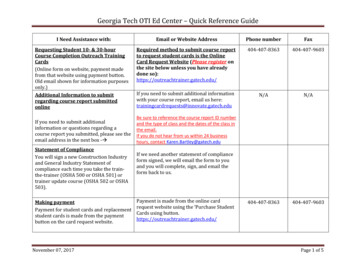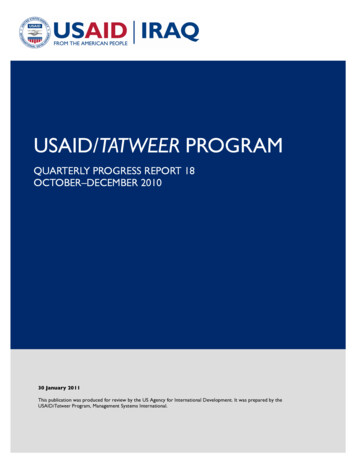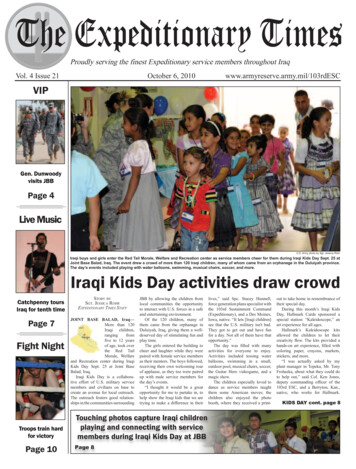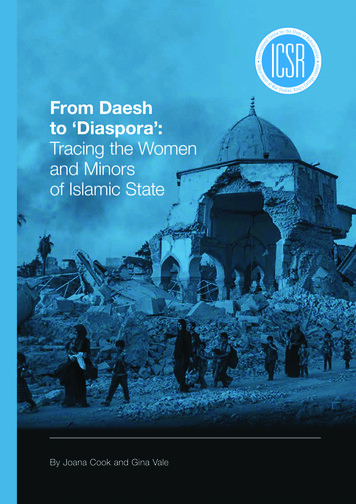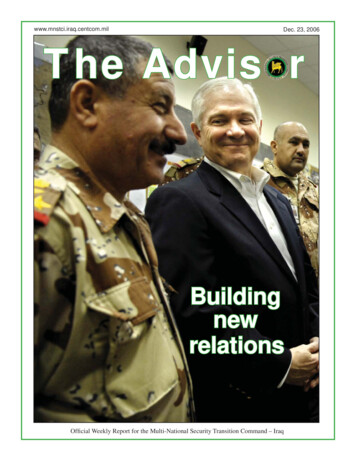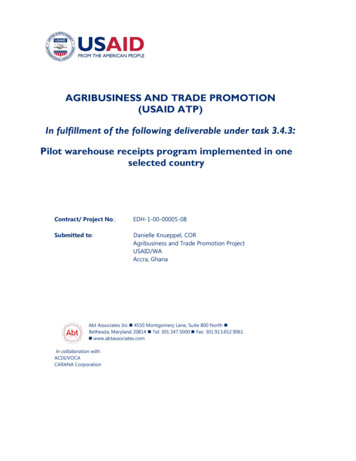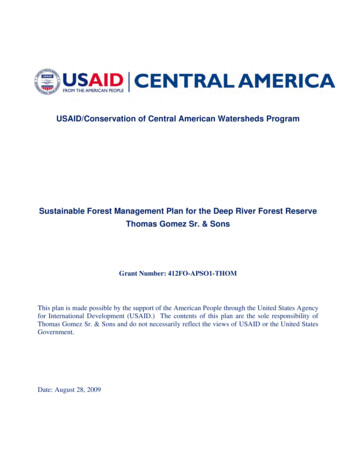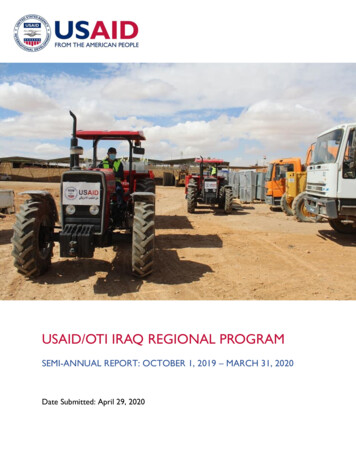
Transcription
USAID/OTI IRAQ REGIONAL PROGRAMSEMI-ANNUAL REPORT: OCTOBER 1, 2019 – MARCH 31, 2020Date Submitted: April 29, 20200
USAID/OTI IRAQ REGIONAL PROGRAMSEMI-ANNUAL REPORT: OCTOBER 1, 2019 – MARCH 31, 2020Contract No: AID-OAA-I-14-00006, Task Order 7200AA18F00019Cover Photo: Municipal workers utilize tractors provided by the Iraq Regional Program toremove waste in Rutba, Anbar province.DISCLAIMERThe authors’ views expressed in this publication do not necessarily reflect the views of the UnitedStates Agency for International Development or the United States government.0
TABLE OF CONTENTSAcronyms . 2Program Description . 3Country Context . 4A Year in Power: Mahdi’s Broken Promises. 4“We Want a Homeland” – The Country Gripped by Protests. 5Tensions Escalate between the U.S. and Iran . 5An Uncertain Political and Economic Future for Iraq . 6Timeline of Key Political and Security Events . 7Activity Highlights . 8Mosul . 8Ninewa Plain . 9Sinjar . 11Western Anbar. 12Strengthening Education Services in Conflict-Affected Areas . 13Monitoring, Evaluation and Learning . 14Adaptive Monitoring, Evaluation, and Learning Systems: COVID-19 Response . 14Leveraging External Research for Program Learning: Perceptions of USAID Branding and Marking . 14Program Operations . 15Footprint . 15Staffing . 15Temporary Relocations and Remote Management. 15Information Technology and Security . 15Next Steps and Priorities . 171
ACRONYMSAAMAdil Abd al-MahdiCDDCivil Defense DirectorateCoRCouncil of RepresentativesCOVID-19Coronavirus disease 2019DCRDeputy Country RepresentativeGMUGrants Management UnitGoIGovernment of IraqIDPInternally Displaced PersonIRGCIslamic Revolutionary Guard CorpsIRPIraq Regional ProgramISISIslamic State of Iraq and SyriaKRIKurdistan Region of IraqKRGKurdistan Regional GovernmentMELMonitoring, Evaluation, and LearningOTIOffice of Transition InitiativesPMFPopular Mobilization ForcesUNDPUnited Nations Development ProgrammeUSAIDU.S. Agency for International Development2
SECTION 1PROGRAM DESCRIPTIONThe Iraq Regional Program (IRP), referred to locally as the Iraq Community Resilience Initiative-Ta’afi(ICRI-Ta’afi), is a program launched by USAID’s Office of Transition Initiatives (OTI) in September 20181to accelerate recovery in conflict-affected areas and strengthen the social fabric of Iraqi communities. IRPuses a quick-response mechanism to implement activities in Western Anbar, Mosul, the Ninewa Plain, andSinjar, leveraging ongoing stabilization and recovery efforts and seizing windows of opportunity.During the reporting period, IRP took the results of its September 2019 strategy review session andrevised its strategic framework to focus on the following program objectives: Objective 1: Recovery in liberated areas is accelerated; andObjective 2: Social fabric of Iraqi communities is strengthened.REGIONNEW ACTIVITIES CLEARED(October 1, 2019 – March 31, 2020)National9Western Anbar8Mosul18The Ninewa Plain7Sinjar10From October 1, 2019, to March 31, 2020, IRP launched 52 new activities worth an estimated 9 millionwith 43 partners during the reporting period, primarily across two conflict-affected Iraqi provinces2. IRPimplemented activities in Iraq’s Ninewa province, where many of Iraq’s minority communities reside, aswell as in Iraq’s vast Anbar province. For example, in Mosul, IRP provided specialized equipment andvehicles to the Water Directorate and rehabilitated the Mosul Cardiac Surgery Center. In the NinewaPlain, IRP’s assistance enhanced critical service provision by allocating heavy machinery and equipmentsuch as water tankers and generators to public providers. IRP also supported small business owners inMosul, the Ninewa Plain, and Sinjar by restoring shops and markets and delivering trainings. In Anbar, IRPequipped water stations with generators to improve potable water supply in remote villages. AcrossNinewa and Western Anbar, IRP continued working with the Iraqi Civil Defense to improve emergencyresponse services, notably in response to fires and floods. While these activities contributed to increaseresilience in targeted communities, IRP’s assistance also addressed issues challenging Iraq’s social fabric inthe post-ISIS era. Additional details can be found in Section 3.Due to procurement delays during the award process, project startup was delayed until January 2019.A total of 78 activities, including the 52 cleared during the reporting period, were under implementation over thesame period. This includes activities that were subsequently suspended during the reporting period due to COVID19.123
SECTION 2COUNTRY CONTEXTTwo and a half years after the defeat of the Islamic State of Iraq and Syria (ISIS), citizens across Iraqcontinue to suffer from limited basic services and worsening economic conditions. ISIS left behind a legacyof physical destruction and eroded the already-strained social fabric within and among Iraq’s diversecommunities. Infrastructure reconstruction and improvements to basic service delivery have progressedslowly, particularly in areas suffering from neglect prior to the ISIS invasion. In addition, the lack ofeconomic opportunities and a paucity in resources have created unfavorable circumstances forencouraging the return of the estimated 1.4 million internally displaced persons (IDPs). Recent attemptsby the Government of Iraq (GoI) to consolidate or close IDP camps forced thousands to return todestroyed homes that lack basic services. Beyond the absence of services, returnees continue to sufferfrom social stigma, which, in some cases, results in rejection, making secondary displacement a seriousthreat to the stability of areas liberated from ISIS.A YEAR IN POWER: MAHDI’S BROKEN PROMISESThe beginning of the reporting period marks a year of the tenure of Adil Abd al-Mahdi (AAM) as a primeminister. His nomination in October 2018 was seen as a compromise, reached by Iraq’s most influentialpolitical parties, to elect a weak candidate that would not oppose their political agendas. AAMsubsequently struggled to form a full cabinet, and his first six months in power were shaped by politicaland armed factions’ attempts to buy and sell ministerial positions.AAM had promised to tackle the presence of security actors outside state control, for the most partoperating under the Popular Mobilization Forces (PMF) umbrella, formed in 2014 in response to GrandAyatollah Ali al-Sistani’s fatwa calling all able-bodied men to join the fight against ISIS. As the threat posedby ISIS diminished, the PMF started imposing their control over the country’s political and economicspheres. While AAM had committed to reform and integrate the majority of the PMF into the Iraqi army,he instead issued a decree instating a separate security apparatus for the PMF with the exception ofBrigade 30, a small but influential Shabak militia led by Waad Qado, and part of Badr Organization. AAMsought to dissolve Brigade 30, but the militia staged protests and blocked strategic roads in response.Other militia and political elites rushed to Brigade 30 to negotiate, and the brigade was ultimately givenadditional weaponry, jobs for its supporters, and was never dissolved. AAM and his government weresubsequently perceived as empowering militias at the expense of state institutions.In early September 2019 in Baghdad, university graduates protested rising unemployment and the controlexerted by powerful political factions over recruitment in the public sector. The government initiallyrefused to meet with a delegation of protesters to address the issue. National media and activists beganairing reports unveiling degree falsifications and expertise among powerful state officials, including thoseoverseeing technical departments. In late September, further protests broke out after AAM removedLieutenant General Abdul-Wahab al-Saadi, along with other high-profile generals credited with the defeatof ISIS, from his post as the commander of the country’s elite counterterrorism forces.In October 2019, tens of thousands of Iraqis took to the streets of Baghdad to protest the government’sfailed attempts to reform the polarizing and sectarian political system, advance the fight against widespreadcorruption in state institutions, improve living conditions, and address youth unemployment. Protesters4
claimed AAM failed to stand against powerful elites and succumbed to external influence. The protestsproved to be a turning point for Iraq.“WE WANT A HOMELAND” – THE COUNTRY GRIPPED BY PROTESTSThe slogan “We Want a Homeland” became the protests’ motto, drawing nationwide support andsolidarity. Unlike other protests in recent years, which were categorized as “seasonal services protests”or had ethno-religious characteristics, the protests that began in October 2019 transcended ethnosectarian divisions, uniting Iraqis across political and ethnic divisions. Students and women of all ages,defying societal barriers, became the backbone of the movement and drove the national conversation toreject sectarian political identities and demand a complete overhaul of the political system.As anger built up on social media and the protests grew, government forces, armed vigilantes, and Iranianaffiliated militias attempted to brutally repress peaceful protesters, killing and injuring many. Videosdocumenting abuses circulated widely on social media, while activists called for nationwide protests,resulting in tens of thousands of people flocking into the streets of Baghdad and major cities in thesouthern provinces. Protests, however, remained limited to Baghdad and southern Iraq, as the semiautonomous Kurdistan Region of Iraq (KRI) and Sunni-majority areas remained quiet. Fearing reprisal andaccusations of ISIS affiliation, Sunni communities largely refrained from holding protests in their areas.Thousands of individuals from these areas, however, traveled to Baghdad to participate. Simultaneously,the Iraqi diaspora gathered cash donations, food, and medical supplies for protesters.In a bid to ease tensions, AAM promised to implement reforms, but the government quickly cut theinternet and restricted media access to the protests, while the death toll among protesters increased.Grand Ayatollah Sistani eventually released a statement calling for AAM to resign, which he proceeded todo. While AAM’s resignation was welcomed by protesters and activists, they released statements callingfor the end of the Iraqi political system that has prevailed since 2003.TENSIONS ESCALATE BETWEEN THE U.S. AND IRANAs protests intensified in federal Iraq, tensions between Iran-affiliated segments of the PMF and the U.S.escalated in late October when the PMF stepped up its intimidation campaigns and attacks against U.S.interests, including military bases and diplomatic posts. IRP programming was subsequently disrupted inseveral areas of Iraq, particularly in the Ninewa Plain and Western Anbar.In the Ninewa Plain, two PMF militias – Brigade 50, led by the polarizing Christian figure Rayan al-Kildani,and Brigade 30 – remain influential and exacerbate tensions between communities. Closely tied to Iranand the PMF leadership, both brigades have frequently disrupted international recovery efforts in the areaby blocking roads, intimidating national and international staff, and diverting assistance. Since late October,IRP partners have reported that both brigades have stepped up their attempts to intimidate internationalorganizations by collecting staff names, visiting field offices, requesting information, and threateningnational staff. This prompted the program to minimize risks by reducing movement and pausingprocurement in affected areas intermittently between late October and December 2019. Concurrently,the program increased security measures and training for field staff, and regularly reviews the risk profilesof beneficiaries, staff, and activities in target communities to ensure the safety of all partners. In WesternAnbar, the presence of PMF militias along the Syrian border also required the implementation of additionalrisk mitigation measures.5
In late December 2019, amid increased tensions, Kataib Hezbollah (KH) launched missile attacks on U.S.led coalition bases, killing one American contractor and injuring four U.S. service members. While KH hadcarried out similar attacks for several months, this attack marked the first American casualties inflicted byKH. The U.S. responded with targeted airstrikes on five KH weapons storage facilities and command postsin Western Anbar and Syria. The strikes triggered riots by pro-Iranian militias in Baghdad, whereprotesters were granted entry to the normally fortified Green Zone and attacked the U.S. Embassy,though no U.S. personnel were harmed. Three days later, the U.S. carried out a drone strike near theBaghdad International Airport killing Iranian Islamic Revolutionary Guard Corps (IRGC) Quds ForceCommander General Qassem Soleimani and PMF Deputy Chief Abu Mahdi al-Muhandis. Iran retaliated bylaunching ballistic missiles against U.S. bases in Iraq, and Iranian proxies stepped up attacks against U.S.forces. Simultaneously, PMF militias in Western Anbar, the Ninewa Plain, and Mosul accused internationalorganizations of being U.S. spies and banned them from entering those areas. IRP subsequently relocatedseveral national staff to Erbil temporarily and temporarily removed expatriate personnel from the country.Partners and beneficiaries alike feared retaliation, which prompted the immediate suspension ofmovements, procurement, and marking for affected activities until late January 2020, as well as a reviewof those areas’ risk profiles.AN UNCERTAIN POLITICAL AND ECONOMIC FUTURE FOR IRAQThree months after AAM’s resignation, Iraq remains without a new prime minister and continues to beled by AAM in a caretaker capacity. Those who were nominated to take on the role – Mohammed TawfiqAllawi and Adnan al-Zurfi – failed to gather sufficient support to form a government. Simultaneously, inthe midst of this political crisis, Iraq recorded its first cases of the coronavirus disease 2019 (COVID-19)at the end of February 2020, following the spread of the outbreak in Iran. Both the GoI and KurdistanRegional Government (KRG) took swift measures to prevent a nationwide outbreak that would havedevastating impact on the country’s economy and health system. The GoI launched a nationwideawareness campaign on TV channels and radio stations, and both governments imposed border closures,quarantined areas with a growing number of cases, banned all religious and social gatherings, suspendedpublic sector work, closed banks and offices, and instructed hospitals to prepare to absorb COVID-19patients.While the outbreak appears to be relatively contained, its economic impact has proven devastating forthe millions of Iraqis relying on daily wages and for small businesses. Campaigns to donate humanitarianassistance, including cash, food baskets, and hygiene kits, have multiplied throughout the country, and thegovernment set up a 504 million compensation scheme for those with no income. The plunge in oilprices, which began at the end of the reporting period, further threatens Iraq’s economy and stability, asthe government may not be able to pay public sector employees nor aid the most vulnerable householdsin the coming months. In IRP program areas, partners and stakeholders called for activities to shift towardsfood security assistance to sustain resilience throughout the crisis. IRP is subsequently developing activitiesto tackle the impact of COVID-19 restrictions on vulnerable Iraqi households.6
Timeline of Key Political and Security DevelopmentsOctober 2019 – March 2020OctoberNovemberDecemberJanuaryFebruaryMarch Prime Minister AAM fires Lt. Gen Abdul-Wahab al-Saadi, commander of theelite counterterrorism forces. University graduates strike and protest in Baghdad, and the governmentresponds violently, igniting protests across several parts of the country. Activists and organizers call for a million-man march on October 25 todenounce government violence and corruption and to call for the resignationof AAM. AAM promises reforms, jobs, and a campaign against corruption. Protestsincrease as his promises fail to convince the public. The U.S. Embassy in Baghdad warns of an imminent attack and asks citizensto exercise caution. Protesters attack the Iranian consulate in Karbala to reject Iranianintervention in Iraq. AAM resigns and undertakes the role of caretaker prime minister. President Salih removes Ninewa’s PMF-aligned Governor Mansour alMareed and appoints popular army commander, Najm al-Jabouri. Kataib Hezbollah targets U.S.-led coalition bases, killing one Americancontractor and injuring U.S. and Iraqi service members. Bases belonging to Kataib Hezbollah and other militias near the Iraqi-Syrianborder are targeted by drones. The PMF blames the U.S. and vows revenge. The U.S. Embassy in Baghdad is attacked during violent demonstrations ledby Iranian-backed militias. The U.S. kills Iranian IRGC Quds Force Commander General QassemSoleimani and PMF Deputy Chief Abu Mahdi al-Muhandis in Baghdad. The U.S. Embassy temporarily reduced the number of personnel in countryamid increased threats against its facilities. Several rockets target the embassy compound and U.S. military bases. The Council of Representatives votes for the removal of foreign troopspresent in Iraq as members of the coalition to defeat ISIS. Tehran targets U.S. bases in Iraq with ballistic missiles. Mohammed Tawfiq Allawi is appointed as the new prime minister-designate. Iraq records its first COVID-19 cases and began discussing plans to counterthe virus. Amid growing dissensions, Allawi fails to form a cabinet and withdraws. The GoI and KRG put the country on lockdown to contain the COVID-19epidemic including complete border closure. U.S. Embassy orders departure of non-essential staff amid security andCOVID-19 concerns. Adnan al-Zurfi is appointed as the new prime minister-designate (butultimately fails to form a government).7
SECTION 3ACTIVITY HIGHLIGHTSDuring this reporting period, IRP programmed in Mosul, the Ninewa Plain, Sinjar, and Western Anbartowards the objectives mentioned above.MOSULTwo years after the defeat of ISIS, Mosul’s neighborhoods, particularly in the western part of the city, havenot recovered due to the extensive damage caused by ISIS and the ensuing conflict to retake the city. Inpart because East Mosul was reclaimed first, it suffered through the conflict for a shorter period andreconstruction began much sooner there than in the West. The recovery in West Mosul is vital to thestability of the city as a whole and the broader province because of its history and diverse population. InMosul, IRP coordinated closely with the United Nations Development Programme (UNDP) to ensureassistance was not duplicative, but complementary to the larger assistance projects implemented throughthe Funding Facility for Stabilization. To that end, IRP implemented 34 activities valued at 8 million inMosul during the reporting period. Examples of that assistance provided include:Improving Safe Water Provision in West Mosul: Throughout the conflict and during the battle for the liberationof Mosul, the city’s potable water network sustained extensive damage. While water pumping stations andpurification plants had been largely repaired, the underground tertiary water network, which deliverswater to neighborhoods and homes, remained damaged, thereby preventing many residents fromaccessing clean water. In response, IRP partnered with the Ninewa Water Directorate, which manageswater supply for Mosul but lacked equipment and specializedmachinery to conduct necessary repairs. IRP allocatedbackhoe loaders, trucks, air blowers, and pumps to thedirectorate so that they could tackle repairs in Mosul’stertiary water network. The directorate’s use of theassistance received wide social media coverage, and thedirectorate says its responsiveness and reactivity haveimproved. This was confirmed by a resident of Mosul, whosaid, “Two maintenance works have been conducted in ourWater Directorate workers perform repairs on thealley, which indicates an improvement in the [Directorate’s] Picturewater network: Water Directorate workers performwork,” and by an excavator driver who mentioned, “I use the repairs on the water networkequipment every day, and I appreciate your assistance. I feel that our work has hugely improved sincemost of the maintenance work requires an excavator.”Civil Defense firefighters tackle a fire in MosulIncreasing the Capacity of the Ninewa Civil Defense: Damage toMosul’s critical infrastructure has affected the city’s ability tocope with natural disasters, such as fires and flooding. InMarch 2019, floods were a factor in the sinking of a ferry onthe Tigris River, highlighting Mosul’s lack of emergency rescuecapacity and prompting protests that eventually led to thedismissal of the governor at the time. To help respond to thiscrisis, IRP established a rapid response mechanism for theNinewa Civil Defense Directorate (CDD), which delivers8
critical emergency response services. Through this mechanism, IRP provided a range of equipment to theCDD. Mosul’s first responders reported that the center’s ability to respond to fires had improved as aresult of IRP’s assistance, citing, for example, the role the equipment played in their response to a largefire that broke out in East Mosul in February. IRP also provided equipment to enable the CDD to respondto floods, including life preservers, pumps, rescue boats, and wetsuits. The CDD has publicly praisedUSAID for its support and shared multiple social media posts showing its employees using the gear andequipment during emergencies.Rehabilitating the Mosul Cardiac Surgery Center: Prior to ISIS’soccupation, the Mosul Cardiac Surgery Center was agovernment-operated medical facility providing critical andaffordable health services to patients coming from acrossIraq. Entirely destroyed by ISIS, the center in West Mosulhas since reopened in another hospital but lacked criticalequipment to receive patients. To tackle this issue, IRPpartnered with the Ninewa Health Directorate to providethe center with furniture, including hospital beds, IT The Mosul Cardiac Surgery Center with hospital beds andequipment, and medical accessories. The head of the center cabinets provided by USAID-OTIreported that the assistance has enabled the center toreopen and provide proximity cardiac care for those who need it.Reviving Mosul’s Old Market: Once a vibrant place in the city,Mosul’s historic blacksmith market bears the brunt of the conflictwith ISIS. Shop owners worked together to remove rubble andfund repairs, but store fronts and awnings remained destroyed. Inresponse, IRP worked with the Directorate of Mosul Municipalityto construct sunshades, repair parts of the market floor (includingrainwater drainage systems), and install light fixtures. Shop ownersexpressed gratitude upon the construction of the sunshades, withone of them saying, “We suffer when it rains. It forces us to close[the shops] and stop working. The lack of shades makes our workeven harder in the summer.”Sunshade awning being installed above blacksmithshopsNINEWA PLAINThe Ninewa Plain is Iraq’s most diverse region, hosting a mosaic of ethnic and religious minoritycommunities, many of which were persecuted by ISIS. Since being reclaimed from ISIS, these communitieshave struggled to recover due to ineffective governance and a competition for control between Iraq’scentral government in Baghdad and the Kurdistan Regional Government at all levels of Ninewa’sadministration. As a result, Iraq’s most vulnerable populations, particularly Christians and Yezidis, havefaced a greater risk of displacement. IRP implemented 18 activities valued at 2.7 million in Hamdaniyaand Tal Kayf districts during the reporting period. Examples of assistance provided include:Equipping Hamdaniya’s Health Clinics and Promoting Hygiene amid the COVID-19 Outbreak: The Hamdaniyahealth department suffered from a lack of critical equipment. To improve residents’ access to criticalhealth services, IRP partnered with the Youth Messengers Organization for Relief and Development toprovide generators to six health clinics and to equip a training center for medical staff. IRP further9
supported the health department in conducting anoutreach campaign to inform residents of best publichealth practices and the services offered by the healthclinics. A medical staff mentioned, “In some villages,people refuse to vaccinate their children, and claim thatvaccines spread diseases, but our staff changed people’sperceptions through these health awareness sessions.”In lieu of a closing ceremony, IRP funded a COVID-19awareness campaign, including community outreach anddistribution of brochures produced by the World HealthOrganization, which was praised by residents. Throughthis support, IRP strengthened Hamdaniya’s health One of the six generators provided to health clinics inservices and residents’ awareness of how to prevent the Hamdaniyaspread of COVID-19.Boosting Hamdaniya’s Civil Defense Capacity: In the summer,extreme temperatures and dryness make the Ninewa Plainextremely vulnerable to fires, putting farmers’ lives andlivelihoods at risk. While less common, fires do also occur inhomes, restaurants, and generator facilities, posing an additionalrisk to civilians. The Hamdaniya CDD, which responds to suchemergencies, had all its equipment destroyed or looted by ISIS.To enhance the CDD’s capacity and efficiency, IRP procured afire truck and water tanker, as well as light equipment andsupplies. The CDD expressed its gratitude upon receiving thesupport and conducted an outreach and awareness session toFire truck and equipment provided to the Hamdaniya inform community members of fire hazard mitigation measures.CDDBringing Back Electricity to Neglected Communities of theNinewa Plain: Located within the disputed territories ofthe Ninewa Plain, Alqosh hosts a large number of IDPs,putting a strain on its limited infrastructure. Communitymanaged generators were breaking down under theincreased demand. With repairs or replacement beingtoo costly, villages in the sub-district resorted to publicelectricity, which is rarely available and led to adegradation in living conditions and reports of residentsdeparting towards Dohuk and Turkey. In response, IRP A generator provided to a community in Alqoshpartnered with the Beban Charity Society, anorganization that had previously managed generators to provide subsidized electricity to residents ofAlqosh, to procure and install three generators and provide fuel for the villages of Beban, Garmawa andDashqotan. Following the provision of generators, some residents reported that the improved stability ofthe electricity means they use less electricity and therefore save money. The head of the Beban CharitySociety noted that the villages previously experienced blackouts of up to 12 hours whereas the new10
generators now provide a reliable and almost constant electricity supply to the community centers,schools, and private houses. This was confirmed by mukhtars, who mentioned that the quality of electricityprovision remains the same regardless of the hour, location, or numb
usaid/oti iraq regional program semi-annual report: october 1, 2019 - march 31, 2020 date submitted: april 29, 2020 . 0 usaid/oti iraq regional program semi-annual report: october 1, 2019 - march 31, 2020 contract no: aid-oaa-i-14-00006, task order 7200aa18f00019
